
|
Sale 31
Pre-Long Beach Coin Auction
| Lot |
Photo |
Description |
Realized |
Lot 2181 |
 |
Great Britain. Gold Touch Piece, ND. Charles II. BMI-86. Holed. St Michael killing a dragon on the obverse and a ship in full sail on the reverse. Used in 'touching' ceremonies, where those who suffered from scrofula were brought to be cured. This is a fine example of a gold coin which was symbolically holed. Normally seen in somewhat lower grades. NGC graded AU-55.
Not everything is as it seems, particularly in numismatics. For most collectors, a holed coin is seen as damaged, to be avoided, and if bought then bought cheaply as a filler until a better example can be located. Holed English gold coins are, indeed, sometimes nothing but damaged goods. However, a class of coins exists for which the hole has meaning, and the coin is seen as a special class of memento whose value is not diminished by having a hole in it. In fact, without a hole the coin would be "nothing but a coin."
This is the famous "touch piece," an example of which is the present lot and lot 2219 as well. Not much has been published about this item, mainly brief comments repeated by subsequent writers. It can in fact be any kind of gold coin but is usually a gold angel. Spink lists such an item as their #2687 without note. Josset stated "The gold coins were made of crown gold except for the angels, of which a small number were struck in standard gold for the ceremony of 'Touching of the King's Evil'. The angels served both the Tudors and the Stuarts at this ceremony, when the coins were hung by the sovereign around the necks of the sick. The ceremony was believed to have been started by Edward the Confessor in 1058, when he was supposed to have healed by touch a woman affected by scrofula, which was afterwards known as King's disease." Sutherland believed that angels were made during the reign of Charles I mainly for this ceremony. Brooke implied that the angel as a denomination was created as a sort of "holy coin" specifically for this purpose, a neat idea but it does not explain the existence of "angelets" or fractions, nor the large mintages of angels in the middle ages. As in many cases, the fame of this coin outshines its factual beginning, and "touch pieces" have been a desirable collectible in England for centuries.
Estimated Value $700 - 900.
The Cheshire Collection.
View details and enlarged photos
| Realized
$661 |
Lot 2182 |
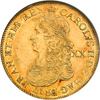 |
Great Britain. Unite, ND. S.3304; Fr-276. Charles II. Gold Unites with a value of 20 Shillings were produced during Charles II's hammered coinage (in the first two years after the 1660 Restoration of the monarchy). This was one of the last of the hammered gold coins. The Unite was replaced by the milled gold Guinea in 1663, this with a value of 20 shillings, subsequently rising to 21 shillings. Here we have an extraordinary example of the final hammered gold issue, boldly marked "XX" for 20 Shillings Gold, with a marvelous portrait of the king and a strongly defined royal shield on the reverse. Reflective luster and some lovely, premium red toning. This is certainly among the finest known examples of this rare gold coin. NGC graded MS-62.
Estimated Value $10,000 - 12,500.
The Cheshire Collection.
View details and enlarged photos
| Realized
$12,650 |
Lot 2183 |
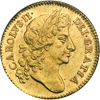 |
Great Britain. Guinea, 1676. S.3344; Fr-287; KM-440.1. Charles II. Fourth laureate bust. Unusually well struck and free from defects. This date was not to be found in the Terner collection. Rare grade. NGC graded MS-62.
Estimated Value $6,500 - 7,500.
The Cheshire Collection.
View details and enlarged photos
| Realized
$6,038 |
Lot 2184 |
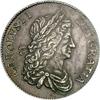 |
Great Britain. Silver Crown, 1663. Charles II. First bust. S-3350. XV edge (notes the slab). A beautifully balanced coin showing very little wear. Slight evidence of roller lines through the top of the king's hair and laurels, as made at the mint during manufacture. A nicely struck coin with few marks of any kind, evidence of die-rust in the fields (London was a very humid place at the time), pleasing medium gray toning with hues of golden green on reverse. Exceptionally fine for this first issue of the classic Charles II crown. Possibly ex Bridgewater House. NGC graded AU-50.
Estimated Value $5,000 - 5,500.
The Cheshire Collection.
View details and enlarged photos
| Realized
$5,520 |
Lot 2185 |
 |
Great Britain. Silver Crown, 1664. Charles II. Second bust. S-3355. Edge not readable in the slab but XVI. Compared to the first issue of 1663, this crown shows the king as if at a slight distance. His portrait is smaller, perhaps less elegant, but more dramatic. This particular specimen is also extraordinary in quality, having very little actual wear, lots of mint luster gleaming beneath handsome, well-set 17th-century golden silvery gray toning. Lots of almost invisible, tiny black carbon flecks in the silvery alloy, but these are typical of their era and do not detract even slightly from the quality and overall beauty of this wonderful crown. As Alan Rayner says in his English Silver Coinage book, page 6, "no crowns of Charles II are common in first class condition." That is a major understatement, in the best English tradition, for a coin of this quality probably figures in the top 1% or 2% of all crowns of this reign. As well, this date is seldom seen in better grade. NGC graded AU-53.
Estimated Value $5,000 - 6,000.
The Cheshire Collection.
View details and enlarged photos
| Realized
$4,140 |
Lot 2186 |
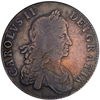 |
Great Britain. Crown, 1666. S.3355; ESC-32. Charles II. Year of the Great Fire of London. Toned. NGC graded VG-8.
Estimated Value $125 - 175.
View details and enlarged photos
| Realized
$299 |
Lot 2187 |
 |
Great Britain. Silver Crown, 1668. Charles II. Second bust. S-3357. Edge not readable in the slab but "VICESIMO." The consignor has not told us, but this is probably the coin he had to represent the 2nd Bust until he located the marvelous 1664 described above. Of course the regnal edge dating style on this coin also differs from that on the 1664, so it's not technically a duplicate. This coin is exceptionally nice, but in a different league from the 1664. It is pale gray, well struck overall, and enjoys a lack of noticeable abrasions. The Cheshire collector stayed far away from any coins having problems, and none of his coins, of any denomination, has edge problems or major marks. His stress was on finding quality or not having the coin in his collection (the same philosophy which guided Dr Terner in his English gold collection). Although not the finest Charles II crown in this wonderful collection, it is nevertheless exceptional and worthy of lots of strong bids. Rare date! NGC graded AU-50.
Estimated Value $4,500 - 5,250.
The Cheshire Collection.
View details and enlarged photos
| Realized
$4,255 |
Lot 2188 |
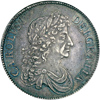 |
Great Britain. Silver Crown, 1672. Charles II. Third bust. S-3358. Edge not readable in the slab but "V. QVARTO." These early milled coins possess many wonderful characteristics, tiny differences which make them enjoyable to study. On this coin the "2" in the date is a huge fat digit compared to the thin "7" just before it. But we quibble. Here indeed is a lovely coin showing only slight wear and a simply wonderful balance of the components which total up to what we like to call "eye appeal." The strike is even and sharp on both sides, with both a delicately detailed shield on reverse and a sensitive portrait of King Charles. Luster emanates from beneath dark gray toning glinting with iridescent hues. A few minute marks and some faint black carbon impurities in the metal, but these are nothing. This is among the finest examples of a 3rd Bust crown to be found anywhere, a highlight of this section of the Cheshire Collection. The consignor notes that this special coin was protected for centuries, and that he does not believe a finer example of the date exists. NGC graded AU-58.
Estimated Value $6,500 - 7,000.
The Cheshire Collection.
View details and enlarged photos
| Realized
$10,925 |
Lot 2189 |
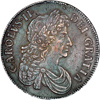 |
Great Britain. Silver Crown, 1673. Charles II. Third bust. S-3358. Edge not readable in the slab but "V. QVINTO." Note the thin digits "73" on this coin. The cataloguer is only guessing but has to think that this is the coin prized by the Cheshire collector until he found the 1672 described above. It's also very possible that each coin appealed to him so much that he had to own them both. NGC has graded this crown AU55 but in reality it is virtually identical to the grade of the 1672, only struck differently. It's well balanced and pleasing, with "dark dusty" toning similar to that of the 1672. Ancient luster gleams from beneath the color, producing a stunning appearance! One of the nicest of this bust style in existence. NGC graded AU-55.
Estimated Value $4,500 - 5,000.
The Cheshire Collection.
View details and enlarged photos
| Realized
$6,038 |
Lot 2190 |
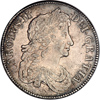 |
Great Britain. Crown, 1676. S.3358; ESC-51; Dav-3776. Charles II. V. Octavo edge. Well struck with under lying luster. Rare this nice. NGC graded AU-55.
Estimated Value $4,500 - 5,000.
The Cheshire Collection.
View details and enlarged photos
| Realized
$3,840 |
Lot 2191 |
 |
Great Britain. Halfcrown, 1677. Charles II. S-3367. 4th draped bust. "VICESIMO NONO" in all probability but the edge is not visible in the slab. Bright with luster. Light gold toning on reverse. Struck from clashed dies. An exceptionally high-grade example of this classic, showing the interlinked C's in between the shield's quadrants on reverse. While there is some disturbance to the luster, the fact that there is luster at all is highly unusual. The vast majority of silver of this reign, and particularly the crowns and halfcrowns, are seldom found in grades better than VF. Almost none still retains any of the original "gleam" seen on this coin. Many of the so-called nicest examples that go through the London sale rooms have been cleaned or are drab but are not so noted in the descriptions. This coin is well-balanced with an above-average strike that is particularly sharp in numerous details (Charles' hair is never seen fully detailed) and surfaces which are far, far finer than on 95% of his halfcrowns, of any date or portrait style. Most flans of this period are also plagued by alloy flaws or poor rolling, but not this coin. A rare type, worth a strong bid! NGC graded MS-63.
Estimated Value $4,600 - 5,000.
The Cheshire Collection.
View details and enlarged photos
| Unsold |
Lot 2192 |
 |
Great Britain. Halfcrown, 1683. S.3367; ESC-490. Charles II. "Tricesimo Quinto" edge. Toned a pleasant medium gray with lilac highlights. Softly struck as are almost all halfcrowns of this period. 2005 Spink value is £2,250 in EF. We expect this coin to bring a bit under that value as this coin would mostly be graded AEF in England. Very rare nonetheless. NGC graded AU-55.
Estimated Value $1,500 - 1,800.
The Cheshire Collection.
View details and enlarged photos
| Realized
$1,725 |
Lot 2193 |
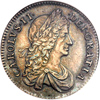 |
Great Britain. Shilling, 1663. S.3371; ESC-1022. Charles II. First bust variety. Coin-die alignment. The first year of the Charles II Shillings and a well-struck, somewhat prooflike specimen with especially attractive medium gray toning. Rare this nice. British bidders should consider it a really Good EF. The cataloguer sees very few this fine, even at the biggest UK coin "fairs" or auctions, even from the premier retailers or auctioneers in the homeland. Cats £850 ($1,700) in EF in the 2005 Spink book. This one should be worth more than that. NGC graded MS-62.
Estimated Value $2,500 - 2,750.
The Cheshire Collection.
View details and enlarged photos
| Realized
$2,185 |
Lot 2194 |
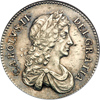 |
Great Britain. Shilling, 1668. S.3375; ESC-1030, Charles II. Second bust. Minor haymarking, trace of luster. Attractive light silvery toning. NGC graded AU-53.
Estimated Value $1,100 - 1,400.
The Cheshire Collection.
View details and enlarged photos
| Unsold |
Lot 2195 |
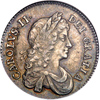 |
Great Britain. Shilling, 1679. S.3375; ESC-1054. Charles II. Second bust. Softly struck in the hair, otherwise traces of luster beneath a light gray tone. Rare in this excellent grade. NGC graded AU-58.
Estimated Value $2,000 - 2,400.
The Cheshire Collection.
View details and enlarged photos
| Unsold |
Lot 2196 |
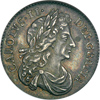 |
Great Britain. Sixpence, 1674. S.3382; ESC-1512; KM-441. Charles II. Exceptionally well struck, somewhat prooflike and deeply toned. Difficult to find a finer example of this scarce date. NGC graded MS-63.
Estimated Value $1,250 - 1,500.
The Cheshire Collection.
View details and enlarged photos
| Realized
$1,093 |
Lot 2197 |
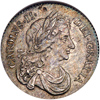 |
Great Britain. Silver Sixpence, 1677. Charles II. S-3382. One of the finest of this type in existence! A truly Uncirculated coin that is both well struck and has exceptional eye-appeal. The surfaces are especially clean. Silvery luster shows beneath handsome gray toning. The portrait is sharp and appealing, lifelike. Obverse legend shows classic bifurcations and is entirely sharp. Reverse legend has a number of interesting die blunders, recut letters but remains sharp and clear. Alloy problems show slightly on the reverse: porosity in the metal and some die-stress. Nonetheless, this coin sets very close to the top of known examples of Charles II's sixpence coinage. Worth a strong bid indeed, as one of the most difficult coins of this denomination to find in high grade. NGC graded MS-63.
Estimated Value $1,250 - 1,500.
The Cheshire Collection.
View details and enlarged photos
| Realized
$1,323 |
Lot 2198 |
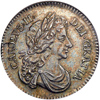 |
Great Britain. Silver Sixpence, 1678/7. Charles II. S-3382. Another excellent example, but this coin, while given the same grade by the slabbers, is not the equal of the 1677. Nonetheless it's a bit rarer as an overdate and very appealing. Similar gray color, well set, original. But the luster is not quite so strong here. And the strike is a bit mushy on reverse. Darker toning appears among the letters. Having "knocked" this coin with the reality of its appearance, it should be now stated that it remains among the finer known coins of this denomination, of Charles II. Few exist even in EF, let alone this higher grade. British collectors will insist it's "Good EF" and that's fine: go find its equal before you squawk too much! NGC graded MS-63.
Estimated Value $1,250 - 1,500.
The Cheshire Collection.
View details and enlarged photos
| Realized
$1,093 |
Lot 2199 |
 |
Great Britain. 6 Pence, 1681. S.3382; ESC-1520. Charles II. Couple of obverse die breaks due to the obverse die deteriorating. Lustrous. NGC graded MS-63.
Estimated Value $750 - 1,000.
View details and enlarged photos
| Unsold |
Lot 2200 |
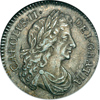 |
Great Britain. Sixpence, 1681. S.3382; ESC-1520; KM-441. Charles II. Deep steel gray toning. NGC graded MS-61.
Estimated Value $750 - 1,000.
The Cheshire Collection.
View details and enlarged photos
| Realized
$719 |
Lot 2201 |
 |
Great Britain. Sixpence, 1684. S.3382; ESC-1524; KM-441. Charles II. Considerable luster beneath lovely iridescent toning. NGC graded MS-63.
Estimated Value $1,250 - 1,500.
The Cheshire Collection.
View details and enlarged photos
| Realized
$1,150 |
Lot 2202 |
|
Great Britain. Pair of Early 4 Pences, 1677 and 1772/0. S.3384, 3750. Charles II and George III. A pair of attractive mint state examples. Lot of 2 coins. NGC graded 1677 MS-64, and 1772/0 MS-65.
Estimated Value $125 - 150.
The Cheshire Collection.
View details
| Realized
$144 |
Lot 2203 |
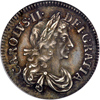 |
Great Britain. Silver Threepence, 1678. Charles II. S-3386. Classic draped bust of the king, and on reverse three interlinked Cs for "Charles" or "Carolo" as he was called in Latin. An unusually nice piece, medium gray and light gold toning, struck quite sharply. Original surfaces. For our British friends, "Good EF"! NGC graded MS-63.
Estimated Value $100 - 125.
The Cheshire Collection.
View details and enlarged photos
| Realized
$104 |
Lot 2204 |
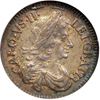 |
Great Britain. Threepence silver, 1679. Charles II. S-3386. Sharply struck but from crumbling dies. Dark iridescent amber and silvery gray toning. One of very few existing of this type, never mind the date, in Uncirculated grade. Very scarce! NGC graded MS-63.
Estimated Value $100 - 125.
The Cheshire Collection.
View details and enlarged photos
| Realized
$86 |
Lot 2205 |
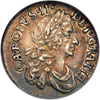 |
Great Britain. Silver Twopence, 1679. Charles II. S-3388. Two interlinked Cs on reverse. For our bidders across the pond: nice English EF with original, dirty surfaces. Medium gray with some gold toning. NGC graded MS-63.
Estimated Value $75 - 100.
The Cheshire Collection.
View details and enlarged photos
| Realized
$75 |
Lot 2206 |
 |
Great Britain. Maundy Set, 1673. S. 3392; ESC-2369. Charles II. Fairly even matching toned set.4 Pence NGC MS-64; 3 Pence NGC MS-62; 2 Pence NGC MS-60; Penny NGC MS-62. Lot of 4 coins.
Estimated Value $700 - 800.
The Cheshire Collection.
View details and enlarged photos
| Realized
$782 |
Lot 2207 |
 |
Great Britain. Pattern copper Halfpenny (1671). Charles II. P-404. Tentative design for the very first copper halfpenny of large size. This style was altered the year after this piece was made, and the result was the currency issue of 1672, S-3393, with plain rims in place of the broad, heavily circled ones on this pattern, and a rearrangement of the reverse devices, with a date in the exergue in place of the tiny word "BRITANNIA" found here. The dies for this "official pattern," as Peck labels it, were engraved by John Roettier, and this coin marks the first-ever appearance of the mythical Britannia on a British coin (which is doubtless why the label naming it was placed in the exergue). As we discussed in describing the pattern "ship" farthing of this monarch, elsewhere in this sale, the legend "QVATVOR MARIA VINDICO" claimed, in theory, the four seas as the king's dominion, and is one of very few references to Britain's sea-power in all of numismatics. This pattern is usually seen in VF or slightly better grade, as most were either spent or carried as pocket souvenirs, but this incredible specimen must be among, or perhaps is, the finest known. Gem Proof, struck in low relief, with awesome milk-chocolate brown surfaces, no flaws on them, the fields still reflective (!), producing wondrous, glossy eye-appeal. A few minute carbon flecks, and a tiny scratch above the shield on reverse. But these are quibbling things on a coin whose very existence defies belief. One of the finest early Proofs this cataloguer has seen, and a star of the Cheshire Collection. Anyone interested in acquiring this coin should also consider bidding on the equally important "ship" farthing pattern in this sale. NGC graded Proof 65 Brown.
Estimated Value $1,600 - 2,000.
The Cheshire Collection.
View details and enlarged photos
| Realized
$1,380 |
Lot 2208 |
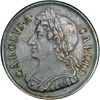 |
Great Britain. Proof copper Halfpenny, 1672. Charles II. Style of S-3393. No error in the legends. Peck-509. Cope & Rayner rate this R4 in Proof. Peck calls it "very rare." 30.5 mm diameter. Edge not viewable in the slab, but as Peck says "Proofs have a plain linear circle instead of the toothed border." Otherwise the two kinds of issues are hard to distinguish. The technical grade is not so much at issue when it comes to finding any of these coppers, but rather the problem is locating coins without flaws, without damage, without corrosion. Those are the things that plague the coppers of the late 17th century and into the first few decades of the next century. Especially hard to find nice are any coppers of Charles II, James II, William & Mary, and William III, because in reality these were the formative years, a period of crude alloying and clumsy minting presses. Comparable in U.S. numismatics are the first nickel coins, those of 1865 to about 1870, which show that the mint had trouble adjusting press pressures correctly and could not get the alloy right very often. Thus what we have here, in this lot, is a very early British copper of exceptionally pleasing eye-appeal, made of lovely "light chocolate" copper without alloying flaws or much later damage. There is an ancient scuff just behind the king's nose, and another light one on Britannia's front leg. But these are nit-picking marks, for this coin is among the nicest copper halfpennies of this reign to be found. NGC graded Proof 62 Brown.
Estimated Value $2,500 - 2,750.
The Cheshire Collection.
View details and enlarged photos
| Unsold |
Lot 2209 |
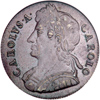 |
Great Britain. Halfpenny, 1673. S.3393. Charles II. Very slight luster traces. This was minted in the second year of halfpenny production in the reign of King Charles II. Although the proof halfpennies were of fine workmanship, the currency coins were generally poorly made and struck off-center with areas of weakness. Overall, this is a well produced coin which had escaped circulation. Rare this nice. NGC graded MS-64 Brown.
Estimated Value $1,400 - 1,700.
The Cheshire Collection.
View details and enlarged photos
| Realized
$1,668 |
Lot 2210 |
 |
Great Britain. Pattern copper "Ship" Farthing (1662). Charles II. P-398. Dies by John Roettier. Straight-grained edge (not visible in the slab). Toothed borders. Diameter 22.5 mm. No portrait but rather a sailing ship is featured, said to be the "Sovereign of the Seas," the largest ship in the water at the time: "Roettier must have copied John Payne's engraving of the vessel, as the details agree very closely." The curious legend, "Quatuor Maria Vindico," translates from Latin to mean "I claim the four seas," which Peck explains was "intended to give prominence to the king's pride and interest in the navy." Peck also rates this variety Extremely Rare. It's also quite exceptional. The color is that of milk chocolate. Some die flaws are evident, but only tiny marks. The surfaces are glossy and most attractive! NGC graded EF-40 Brown.
Estimated Value $1,000 - 1,200.
The Cheshire Collection.
View details and enlarged photos
| Realized
$1,035 |
Lot 2211 |
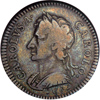 |
Great Britain. Silver Pattern Farthing, 1665. Peck-407. Charles II. Bust left. Reverse: Britannia seated. Toned. Actually grades Fine-12. Actually graded by NGC Proof-12.
Estimated Value $150 - 200.
View details and enlarged photos
| Realized
$230 |
Lot 2212 |
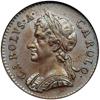 |
Great Britain. Pattern copper Farthing, 1671. Charles II. P-436. Listed by Peck among the "official farthings," and in fact this is the pattern design most often seen, in silver, from this reign. Lower grade silver coins are easily found in England, VF and AEF pieces, but nicer silver ones are seldom found and must be considered very rare in choice condition. However, copper specimens are elusive, particularly this well preserved. Milk chocolate in color, with remnants of luster adhering among the letters, the surfaces emitting a lovely, glossy brown glow. Only tiny marks may be seen. There are some usual, light die-flaws but these are nothing. The king's portrait is especially appealing and well engraved. This beautiful coin is one of the Cheshire Collector's favorites, and we quote his comments and research here: "This great rarity was produced before the beginning of the regular production of farthings in 1672. Farthings were not made available to the public until a week after the proclamation of 16 August 1672 and Peck concludes that we should regard this 1671 farthing as 'the final prototype of the current farthing, struck in anticipation of the proclamation'. Listed by Peck as 'very scarce' the piece is now seldom seen in any grade." NGC graded MS-63 Brown.
Estimated Value $1,400 - 1,600.
The Cheshire Collection.
View details and enlarged photos
| Realized
$1,610 |
Lot 2213 |
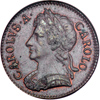 |
Great Britain. Farthing, 1672. Peck-520; S.3394. Charles II. Some luster and traces of red. Rare in grade. NGC graded MS-64 Brown.
Estimated Value $1,200 - 1,500.
The Cheshire Collection.
View details and enlarged photos
| Unsold |
Lot 2214 |
 |
Great Britain. Copper Farthing, 1673. Charles II. S-3394. Second year of the very first Regal Copper of this denomination. For centuries, any coin not made of "specie" (i.e., gold or silver) was suspect of its commercial value, and in the English tradition the earlier copper "coins" were not coins at all, but tokens: witness what C. Wilson Peck labeled "rose farthing tokens" struck during the reign of Charles I (1625-49). Copper curios and "patterns" were made as far back as the reign of Elizabeth I (1558-1603), but only toward the end of her reign, and often in silver. All this was a throwback to the Roman tradition of "subsidiary" or less than royal coins, made for mass consumption but more particularly in order to collect smaller amounts of tax from the citizen of lesser means. Peck points out that the Restoration (1660) brought with it a need for small change that was greater than ever before, with the result that countless kinds and weights of tradesmen's tokens, or necessity pieces, appeared throughout the land. While making such coins was an offense, and an infringement upon the king's right, few such "counterfeiters" were prosecuted. The necessity was real. Influential aristocrats, who sniffed profit as suppliers of copper ore, convinced the warden of the Royal Mint of the need for regal copper coins, and a variety of farthings and halfpennies were made as official patterns, for the first time ever, during the reign of Charles II. Shortly thereafter appeared the first coppers sanctioned by The Crown and bearing the monarch's portrait and titles. The fact that these coins of small intrinsic and purchasing value were very much needed for commerce is evidenced today by their rarity in high grade. Virtually all made saw heavy use, and few were saved by thoughtful historians or collectors of curios. The present specimen is one of the very finest pieces this cataloguer has seen in some 25 years of studying British coins. The surfaces are truly remarkable for this primitive issue! Smooth chocolate brown mixes in perfectly with splashes of orangey mint red. The strike is slightly off-center, as almost always seen. Importantly, there is no corrosion, no dark carbon, and almost no abrasion, not even the most minute. The strike is not full but it is sharp overall, and shows die-clashing. On the king's face is a raised line (not a scratch) which is a die-tooling mark of some sort. The legend and the date are sharp. Although not terribly valuable, this is one of the rarest coppers, in this grade, of all the British copper or bronze issues. Cope & Rayner (English Milled Coinage, 1973) called it R4, or extremely rare, in full Mint State. NGC graded MS-66 Red & Brown.
Estimated Value $2,000 - 2,250.
The Cheshire Collection.
View details and enlarged photos
| Realized
$2,070 |
Lot 2215 |
 |
Great Britain. Farthing, 1675. S.3394. Charles II. A little weakness in striking, virtually as struck with some luster. NGC graded AU-58 Brown.
Estimated Value $1,000 - 1,200.
The Cheshire Collection.
View details and enlarged photos
| Realized
$978 |
Lot 2216 |
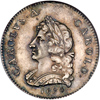 |
Great Britain. Pattern Silver Farthing, 1676. Peck-492. Charles II. Bust left, type with long hair. Reverse: Britannia seated left. NGC graded Proof 62.
Estimated Value $800 - 1,000.
The Cheshire Collection.
View details and enlarged photos
| Realized
$805 |
Lot 2217 |
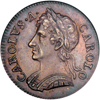 |
Great Britain. Farthing, 1679. S.3394. Charles II. Well struck on obverse with some minor weakness on the reverse. NGC graded MS-63 Brown.
Estimated Value $900 - 1,100.
The Cheshire Collection.
View details and enlarged photos
| Realized
$834 |
Lot 2218 |
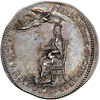 |
Great Britain. Silver Coronation Medal, 1661. Charles II (1660-85). Eimer-221. The official issue of the Royal Mint. Plain edge. 29 mm is the classic size, but this one is wider horizontally, 31 mm. King's portrait facing right, crowned and in the coronation vestments, signed "TS" on the truncation by Thomas Simon. Reverse shows the newly crowned king seated in the Coronation Chair with the Angel of Peace above his head, blessing him. Dated April 1661. A particularly attractive specimen, Choice AU, toned a gorgeous multi-hued "Renaissance gray." Few exist so fine! A luxurious reminder of its age.
Estimated Value $500 - 600.
The Cheshire Collection.
View details and enlarged photos
| Realized
$546 |
|
|